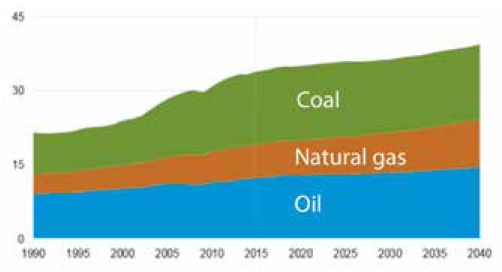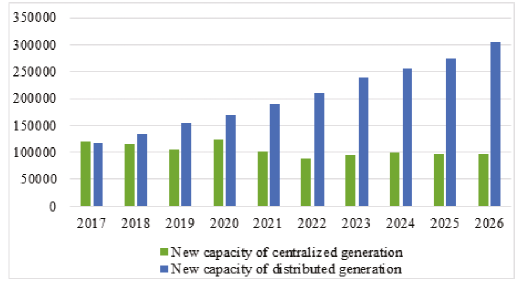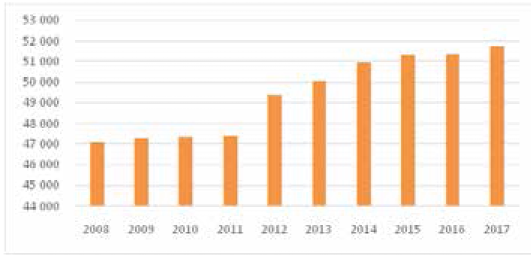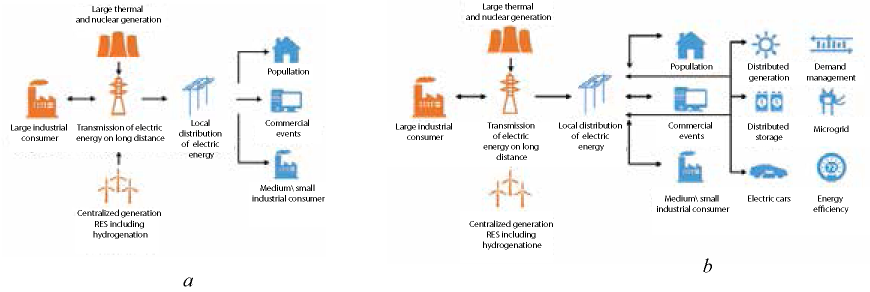Scroll to:
THE CONCEPT OF INTERNET OF ENERGY IN RUSSIA: DRIVERS AND PERSPECTIVES
https://doi.org/10.17747/2078-8886-2018-3-60-65
Abstract
The energy crisis and carbon dioxide emissions have become two of the most important problems in the world. As a very promising solution to these problems is the concept of Internet of Energy (IoE). The Internet of energy is a new energy generation paradigm that develops the revolutionary vision of an intelligent network, and tries to answer the question: how it is possible to achieve coordination and optimization in the macro-energy system.In this study we identify and systematize drivers that promote the implementation of IoE and identify the key benefits that can be obtained by implementing this system.
For citations:
NALBANDYAN G.G., KHOVALOVA T.V. THE CONCEPT OF INTERNET OF ENERGY IN RUSSIA: DRIVERS AND PERSPECTIVES. Strategic decisions and risk management. 2018;(3):60-65. https://doi.org/10.17747/2078-8886-2018-3-60-65
There are significant changes in the electrical energy industry currently, which are primarily connected with digitization, the penetration of the Internet of Things and intellectual methods of management in various sectors of the economy. Electrical energy industry is one of the key areas contributing to the development of society, which is the basis for the functioning of other sectors of the economy. Power industry transformations mainly contribute to:
Energy consumption growth. According to BP's forecast, until 2040 the global demand for electricity will grow by 1.3% annually compared to the 2016 level. The International Energy Agency forecasts annual growth of 3.4%. Growth is expected mainly due to developing economies: China, India provide more than a quarter. Drivers of increase in demand for electricity is also an increase in the welfare of the population in developing countries. [BPEnergyOutlook, 2018]. According to the forecast of the Center for Strategic Research, there will be 4 billion of new consumers who do not yet have access to electricity, and another 1.6 billion people due to the increase in population in the world by 2035 As a result, electricity consumption will increase by 40-50% by the indicated date [Knyagimn V.N., Kholkm D.V., 2017]. The forecast requirement for primary energy resources will increase by 10-17% in Russia, from 2015 to 2040.[Makarova A. A., Grigorieva L. M., Mitrova T. A., 2016].
Increase in demand, therefore, generation of electricity. Growth in demand leads to increase of pollution. According to the US Department of Energy, global carbon dioxide emissions from burning fossil fuels will increase by 16% from level of 2015 by 2040 (Fig. 1).
Fig.1. Carbon dioxide emissions by type of fuel, actual values and forecast, billion [International Energy Outlook 2017]

Enhancing of energy efficiency role. According to the report of the International Energy Agency (IEA), measures taken by the main countries- founders of the IEA (Germany, Japan, Italy, France, United Kingdom), allowed to reduce energy consumption by 20% in 2016 and reduce the GDP energy intensity. As a result, the products of its manufacturers have become more competitive in the international market. In order to analyze energy efficiency on the global scale, 25 countries were selected, among them Russia was only in 20th place, Thailand, South Africa, the United Arab Emirates and Saudi Arabia were lower [Castro- Alvarez F., Vaidyanathan S., Bastian H. et al., 2018]. Today, the energy intensity of Russia's GDP is about twice as high as the world average. Thanks to the measures of the state program of the Russian Federation “Energy Efficiency and Energy Development” [Decree, 2014] implementation, the energy intensity of GDP was reduced in 2015 in comparison to 2007 by 5.94% [Decrease, [bg]], in 2016 - by 1.9% [State Report, 2017]. A reduction of 40% is planned by 2020,, and it will not be easy to achieve, because current socio-economic conditions are significantly different from those in 2008 when the plan was drawn up.
The encreasing role of renewable energy sources (RES). The share of RES in the total global structure of energy production (including hydropower) was about 25% in 2017. 20% of energy from RES was provided by solar installations, 30% - by wind generators. RES provides 30% of energy produced in Europe, 25% in China, about 20% in the USA, India and Japan [GlobalEnergy, 2018]. According to European Commission estimates, the introduction of smartgrids and the use of smart meters will reduce the annual consumption of primary energy in the EU by 9% by 2020 [Renewable energy statistics (2018)] and reduce harmful emissions. Experiments have shown that RES make possible to abandon completely traditional energy sources, but only for a limited time. So Portugal abandoned the use of coal and gas as energy sources from 7 to 11 May in 2016. During this time, the production at wind and hydroelectric stations was 632.7 GW h of electricity, or 45% of the total output. Other electricity was obtained through solar electric plants and power plants on animal and plant materials, for example, on wood, peat, etc. [Y. Vorobieva, 2016].
Solar energy is projected to become the main source of energy among RES, and the share of electricity generated by RES in the overall energy structure will reach 40% [World Energy Outlook 2017, [sa]].Navigant Research predicts that in 2018 more distributed generating capacities will be introduced than centralized generation, the gap between them in terms of the introduction of new capacities will be in three times by 2026 [Role, 2017] (Fig. 2).
The share of RES is about 1% in Russia,, this parameter is increasing annually (Fig. 3). The slow transition to "green" energy is determined by the specific features of the territories and climate, the historically established structure of the power industry. Electric power from traditional sources is of relatively low cost [Linder N.V., Trachuk A.V., 2017].This is largely owing to cross-subsidization: the population pays for electricity at a price below cost, industrial consumers compensate for the difference [Trachuk A.V., Linder N.V., 2017]. As a result, the cost of electricity for the population in Russia is lower than for residents of European countries.Thus, there are no incentives for a fundamental transition to renewable energy sources.
Fig. 2. The forecast for the introduction of newcapacities of centralized and distributed electricity generation in the world, MW [Role, 2017]

The above mentioned global trends are drivers that contribute to finding solutions for optimizing the operation of the power grid complex, improving the reliability and efficiency of the nets.
Today, many countries are interested in moving from the traditional energy system to a distributed energy industry, in which the interaction of various elements of generation in real time is possible. Distributed generation is a set of power plants located close to the place of energy consumption and connected either directly to the consumer or to the distribution electric network (if there are several consumers).This is regardless primary energy source type (for example, fossil fuel or renewable energy), the station’s ownership by a consumer, a generating or grid company, or a third party [A. Khokhlov, Y. Melnikov, F. Veselov, et al., 2018].
Distributed generation is a new model of the energy market. Its active participants are electricity consumers who can install their own generating capacity, partially or fully meet their electricity needs. Consumer can sell electricity surplus to other market participants. Operational cooperation between market participants can provide Internet energy - a set of technologies and business models that ensure the possibility of flexible horizontal interaction of “all with everyone” regarding the production, transmission and consumption of electricity. Thanks to the Internet of energy, the traditional roles of market participants in the electric power industry will change, in particular, one participant will be able to combine the roles of consumer and producer of energy.
The Internet of Energy complements the intelligent network - Smartgrid introduced in some regions of Russia, equipped with sensors that allow you to exchange a lot of information, including weather conditions, electricity prices, consumption in various periods of time, etc. Thanks to the mechanisms of artificial intelligence, it is possible to analyze this information, to make a forecast of electricity consumption in the future, which meets the requirements of the consumer most accurately in terms of volume, price, time of electricity consumption. This altogether makes possible to produce, store and use electricity more efficiently, to balance supply and demand, using the Internet, information collection, processing and analysis technologies.
Fig. 3. The amount of electricity generated by renewable energy sources in Russia, MW [IRENA, 2017]

There are various approaches to what the Internet energy should be. Many concepts use terms of information technology (IP address, router, communication protocol, etc.), in others, terms used in descriptions of an intelligent network.
The Internet is a network based on communication protocols with a common language and other computers can be connected to it. Specific information exchange processes can be assigned to specific recipients. The sending of any information may be planned, saved or postponed in time.
The flow of electricity follows physical laws that differ from the laws of information flow. CThe generated electricity and energy used by the consumer (including energy loss and storage devices) must be balanced at every instant. The flow of electricity follows the Kirchhoff rules, where on each electrical node the input and output must be balanced at every instant and there is no possibility of saving or delay. There are balanced relationships even with an abnormal state of the power grid. Power imbalance will occur only on the rotors of the generator or the rotors of the engine.
The Internet of energy is a symbiosis of physical systems and an information network, so information flow must fully support the security and optimization of the entire flow of energy.
So the Internet of energy is a network of generation, transmission and distribution of energy, enhanced by digital control, monitoring and telecommunication capabilities. It provides not only a two-way flow of electricity in real time, but also an automated two-way flow of information.
Consequently, all interested parties in the power supply chain (from generating stations to commercial, industrial and residential consumers) receive complete information about the flow of electricity and the transport infrastructure.
It is necessary to introduce new digital sensors and actuators in order to add intelligence to the existing infrastructure. This new layer of digital equipment brings together all the assets, in fact represents the Internet of things in action.
The Internet of Things is built by integrating Internet connections into various installations, equipment and devices, connecting these devices to intelligent networks and using the data transmitted by these devices to make meaningful and effective decisions. This means the distribution of computational information across the entire infrastructure in the context of an intelligent network. Thus, the energy sector will use a variety of elements - from embedded sensors in blades of wind turbines that control their step, rotation and function in real time, depending on wind conditions, substation control systems that quickly respond to abnormal occurrences and minimize downtime in relation to nets disruptions.
However, the real value of the Internet of Things is that it creates the opportunity to realize the potential of data that exists in existing, unrelated infrastructures. System operators can use analytics, simulation models and what-if scenarios after collecting data on every aspect of the power supply chain in order to create more accurate predictions for a wide range of factors ranging from network conditions to weather conditions. The possibilities associated with predictive analytics and transition from reactive to preventive operations are one of the defining and most important features of an intelligent network. Electric companies and system operators will receive the following benefits:
- Reduce of capital expenditures. You can more accurately predict the adequacy of supply and demand thanks to the intelligent network. Utilities can meet peak demand without the use of additional generating capacity and can provide the most effective distribution ways, which minimizes transportation costs and ensures optimal operation of assets.
- Demand management. A deep understanding of consumption patterns and improved predictive abilities will allow you to realize more energy saving initiatives, balance supply and demand, and minimize losses caused by base or peak loads.
- Increasing the possibility of using RES. Utilities can more effectively respond to the intermittent supply of electricity derived from RES, which can be influenced, for example, by its seasonal nature, and also maintaining the stability of supply.
- Reduction in operating costs Analysis of various generators activity, transmitting and distributing assets allows you to diagnose faults remotely and provide operational technical support where it is needed at the moment.
- Improvement of client interaction. Electricity providers are increasingly required to compete in unregulated markets and achieve energy savings targets in regulated markets. Electricity companies can use the information provided by consumers themselves in order to develop a more accurate consumption model and provide customized services.
In other words, the Internet of energy is an intelligent energy management system that allows you to maintain the stability and efficiency of the entire emerging decentralized energy model (Fig. 4).
Fig.4. Comparison of traditional (a) and emerging decentralized (b) energy models

Many European countries are engaged in the implementation of national programs for the development of intelligent networks. During 2011-2014, Germany, Great Britain, Denmark, France, Austria, Sweden, Slovenia and Ireland adopted road maps and strategies for the implementation of intelligent networks, involving government support, including financial support. [Digital Technologies, 2017].
Also within the framework of the European Union-funded project, Artemis Internet of Energy project, Siemens researchers have studied how electric vehicles can be integrated into the energy infrastructure. Electric cars will consume much more energy than existing energy systems can generate. If millions of electric vehicles were already connected to the transportation network, there would be power outages. However, vehicles can also be used as energy buffers and return unused electricity back to the grid. So, electric vehicles can create problems for energy systems in their current form, respectively, the latter need to be improved.
According to experts Siemens, the solution lies in creating the Internet of energy, which will allow consumers and manufacturers to coordinate more effectively supply and demand. Intemet energy must be equipped with intelligent forecasting systems that will use weather forecasts, expected traffic flows, and other information in order to predict future energy demand.
Those countries where an active policy for the implementation of intelligent networks is carried out, the decrease in electric power losses during transmission and distribution of energy is being observed (Fig. 5). In the report for 2016 (the USA) was mentioned that as a result of the development of intellectual energy, the index of the average duration of outages for the system was reduced by 20%, the average number of long interruptions in power supply per consumer - by 30% [Distributionautomation, 2016].Also, most of the installed capacity of distributed energy resources is not generation in the United States, but a price-dependent reduction in consumption and energy efficiency measures. Only programs on stimulation of electricity consumption reduction in the hours of highest demand can reduce peak consumption (and, accordingly, the need to build additional units and network infrastructure) by 5-6%, which is several dozen gigawatts on the US scale. For example, ConEdison saved more than $ I billion of investments, which was required in order to expand network infrastructure in several districts of New York by launching a large-scale program for reducing the load of 52 MW during peak hours, spending $ 200 million on its implementation.The program involves numerous measures — from replacing bulbs with more efficient ones to installing energy storage devices at consumers.
In 2016, Russia also adopted the «EnergyNet» roadmap, which aims to occupy 10-12% in the segment of reliable and flexible intelligent networks and 3-6% in the segment of intelligent distributed energy by 2035. Pilot projects are being implemented as part of this initiative, the objectives of which are: to improve the reliability of electricity supply, to reduce the time spent on eliminating accidents, to reduce electricity losses and to optimize operating costs. Thus, since 2016, Yantarenergo(Kaliningrad region) has been implementing a project on the introduction of smart meters, and 290 million rubles have been invested in the implementation of the project at the Mamonovskaya and Bagrationovsky district power plants. According to estimates made by Yantarenergo specialists, smart grids will pay for themselves within 8-9 years. As a result of the project implementation, smart meters reduced the electric power losses by 37%, the time of detection of the site where the accident occurred, and the time of its liquidation was reduced five times [Draft, 2017].
In the Tula region “Tulenergo”, a branch of IDGC of Center and Volga Region, PJSC, installed more than 32 thousand intelligent electricity metering devices for individuals and legal entities. At the end of 2017, electricity losses were reduced by 23.7 million kWh. The introduction of smart metering has reduced the losses associated with inaccurate metering of electricity supplied, the malfunction of meters, and prevented the theft of electricity [In 2017, the branch, 2017].
Since 2013, the company Siemens and BESK have been engaged in the implementation of intelligent networks in Ufa. It is planned that as a result of the project implementation the electric grid complex of the city will fully switch to intellectual management. In 2014, electric power losses decreased by 16- 17%; according to companies, losses will decrease by 2 times compared to existing ones by 2020.[Sharovarov D., 2016].
In 2016, elements of “smart networks” were introduced in Kazan, Naberezhnye Chelny and Nizhnekamsk. The results of intelligent technologies introduction are following: the average time of interruptions of power supply in distribution networks equipped with compartmentation systems decreased by 32%, the average frequency of outages - by 37%. These reliability indicators are reliably comparable with the results of the activities of the Eastern European electric grid organizations.Positive dynamics is observed: since 2016, the duration of outages has been reduced from 206 to 118 minutes per consumer, and the number of outages per year from 4 to 2 [Semerkin S., 2018].
The introduction of intelligent networks and Internet energy should be comprehensive, the greatest effect can be expected only with the general transition to intelligent, distributed energy. Internet energy provides users with great opportunities and, at the same time, presents increased demands on network security and existing market model. Internet of energy suggests that a new type of consumer will appear, elements that were not a part of the traditional market model. According to the above mentioned the changes should be accompanied by the development of a regulatory framework that would take into account new requirements.
Figure 5 Dynamics of losses in the transmission and distribution of electricity in 2005-2015,% [Digital technologies, 20171

The large-scale introduction and development of the Internet of energy in industrial applications should take into account the following factors:
- scalable integration of distributed alternative energy sources with other available electrical grid systems;
- improved measurement, monitoring and control systems: observability, controllability and predictability are critically important aspects of the Internet of energy existence , real-time monitoring and control are possible only with accurate data on energy consumption, a deep analysis of the user consumption model is needed.
- data management in the field of cybersecurity and privacy: Internet of energy provides the exchange of information large amounts between the participants of the electricity market, increased requirements for the security of transmitted data, preventing possible information leaks, protection against unauthorized interference.
References
1. In 2017, the branch "Tulenergo" installed more than 32.5 smart electricity metering devices APIFMS(2018) // URL: http://newstula.ru/fn_329200.html.
2. Vorobyova Yu. (2016) The sun, wind and water: Portugal lasted 107 hours on the "green" energy (2016) // Vesti.ru.URL: https://www.vesti.ru/doc.html?id=2759535&tid=107662.
3. 3. Voskanyan E. (2015) From consumers to partners: in the energy industry of the future, one of the key roles is assigned to consumers // Energy and Industry of Russia. URL: https://www.eprussia.ru/epr/278/4315508.htm.
4. 4. State program "Energy saving and energy efficiency for the period up to 2020" (2010) // Ministry of Energy of the Russian Federation. URL: https://minenergo.gov.ru/system/download/441/445.
5. 5. State report on the state of energy conservation and energy efficiency in the Russian Federation in 2016 (2017) // Ministry of Energy of the Russian Federation.URL: https://minenergo.gov.ru/system/download-pdf/5197/76456.
6. How innovations change people's lives ( [б.г.]) // Siemens. URL: http://siemens.vesti.ru/smart-grids
7. 7. Knyaginin V.N., Kholkin D.V. (2017) Digital transition in the electric power industry of Russia: Expert-analytical report // Center for Strategic Research.URL: https://csr.ru/wp-content/uploads/2017/09/Doklad_energetika-Web.pdf.
8. Linder N.V., Trachuk A.V. (2017). The impact of cross-subsidies in electricity and heat-and-power engineering on changes in the behavior of participants in the wholesale and retail electricity and heat markets // Effective crisis management. 2017. №2. С.78–86.
9. 9. Resolution of the Government of the Russian Federation of April 15, 2014 N 321 (ed. 03/30/2018) “On approval of the state program of the Russian Federation“ Energy Efficiency and Energy Development ”// Consultant Plus. URL:http://www.consultant.ru/document/cons_doc_LAW_162194/.
10. 10. Forecast of energy development in the world and Russia 2016 (2016) / Ed. A. A. Makarova, L.M. Grigorieva, T.A.Mitrova; IES RAS –AC under the Government of the Russian Federation.М 156 с.
11. The project of a digital radio electronic system was presented to Dmitry Medvedev (2017) // Yantarenergo. URL: http://www.yantarenergo.ru/press-center/novosti-kompanii/proekt-cifrovogo-res-predstavili-dmitriyu-medvedevu.
12. The role of microgeneration based on renewable energy in the development of distributed energy in Russia (2017) // Moscow School of Management Skolkovo». URL: https://events.vedomosti.ru/media/materials/materials_0-41324120353862437/download.
13. Semerkin S. (2018) New era in power engineering // Republic of Tatarstan.URL: http://rt-online.ru/novaya-epoha-v-energetike/.
14. Energy management systems of the future (InternetofEnergy) ( [s.a.]) // URL: https://energy.skolkovo.ru/ru/senec/research/internet-of-energy/.
15. Reducing the energy intensity of GDP ([bg]) // Ministry of Energy of Russia. URL: https://minenergo.gov.ru/node/441.
16. Trachuk A.V., Linder N.V. (2017) Cross-subsidization in the electric power industry: approaches to modeling the decrease in its volume // Effective crisis management.№ 1 (100). С. 24–35.
17. “Smart” energy meters reduce its theft and losses by 10–30% (2017) // ТАСС. URL: http://tass.ru/ekonomika/4231354.
18. 18. Khokhlov A. (2017) Renewable energy sources: a new revolution or another bubble // Forbes. URL: http://www.forbes.ru/biznes/343591-vozobnovlyaemye-istochniki-energii-novaya-revolyuciya-ili-ocherednoy-puzyr.
19. Khokhlov A. Veselov F. (2017) InternetofEnergy: how distributed energy will affect safety, electricity prices and ecology // Forbes. URL: http://www.forbes.ru/biznes/351485-internet-energy-kak-raspredelennaya-energetika-povliyaet-na-bezopasnost-ceny-na.
20. Khokhlov A., Melnikov Yu., Veselov F., etc. (2018) Distributed Energy in Russia: Development Potential // Skolkovo. URL: https://energy.skolkovo.ru/downloads/documents/SEneC/Research/SKOLKOVO_EneC_DER-3.0_2018.02.01.pdf.
21. Digital technologies in the grid complex: Energy Bulletin (2017) // Analytical Center under the Government of the Russian Federation // URL: http://ac.gov.ru/files/publication/a/14737.pdf.
22. Sharovarov D. (2015) The power of intelligence for the power supply of cities // Siemens. URL: https://www.siemens.com/ru/ru/home/kompaniya/klyuchevye-temy/ingenuity-for-life/besk.html.
23. Experts discussed the prospects of the project “Smart networks” on the examples of the Kaliningrad region and Sevastopol (2017) // Yantarenergo.URL: http://www.yantarenergo.ru/press-center/novosti-kompanii/eksperti-obsudili-perspektivi-proekta-umnie-seti-na-primerah-kaliningradskoy-oblasti-i-sevastopolya.
24. BPEnergy Outlook 2018 URL: https://www.bp.com/content/dam/bp/en/corporate/pdf/energy-economics/energy-outlook/bp-energy-outlook-2018.pdf.
25. Distribution automation. Results from the Smart Grid investment grant program (2016) // U.S. Department of Energy. URL: https://www.energy.gov/sites/prod/files/2016/11/f34/Distribution%20Automation%20Summary%20Report_09-29-16.pdf.
26. Global Energy Statistical Yearbook (2018). URL: https://yearbook.enerdata.net/renewables/renewable-in-electricity-production-share.html.
27. Hassenmüller H.( [s.a.]) A Fluctuating Balance // Siemens. URL: https://www.siemens.com/innovation/en/home/pictures-of-the-future/energy-and-efficiency/smart-grids-and-energy-storage-internet-of-energy.html.
28. Castro-AlvarezF., VaidyanathanS., BastianH. et al. (2018) The 2018 ACEEE International Energy Efficiency Scorecard //URL: http://www.efficienzaenergetica.enea.it/allegati/Report_ACEEE%202018.pdf.
29. International energy outlook 2017 (2017) // U.S. Energy Information Administration // URL: https://www.eia.gov/outlooks/ieo/pdf/0484(2017).pdf.
30. IRENA Renewable Energy Statistics (2017) // The International Renewable Energy Agency URL: http://www.irena.org/-/media/Files/IRENA/Agency/Publication/2017/Jul/IRENA_Renewable_Energy_Statistics_2017.pdf.
31. Renewable energy statistics (2018) // Eurostat. URL: http://ec.europa.eu/eurostat/statistics-explained/index.php/Renewable_energy_statistics.
32. The International Energy Efficiency Scorecard ([s.a.]) // ACEEE. URL: http://aceee.org/portal/national-policy/international-scorecard.
33. The Internet of Energy: Architectures, Cyber Security, and Applications (Part II) (2017) // URL: http://ieeeaccess.ieee.org/special-sections-closed/internet-energy-architectures-cyber-security-applications-part-ii/.
34. World Energy Outlook 2017 ([s.a.]) // International Energy Agency. URL: https://www.iea.org/weo2017/#section-2-2.
35.
About the Authors
G. G. NALBANDYANRussian Federation
Graduate of the Department of Management, Assistant The Federal State Educational Budgetary Establishment of Higher Education “Financial University at the Government of the Russian Federation”, Research interests: development strategies of industrial companies, entry to international markets, cooperation between companies, transformation of business models, digital business.
T. V. KHOVALOVA
Russian Federation
Graduate, Assistant of the Department of Management, Financial University at the Government of the Russian Federation. Research interests: strategy and management of the power engineering company development, implementation of innovations, cross-subsidization.
Review
For citations:
NALBANDYAN G.G., KHOVALOVA T.V. THE CONCEPT OF INTERNET OF ENERGY IN RUSSIA: DRIVERS AND PERSPECTIVES. Strategic decisions and risk management. 2018;(3):60-65. https://doi.org/10.17747/2078-8886-2018-3-60-65









































